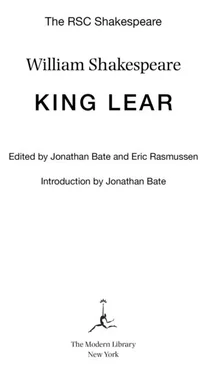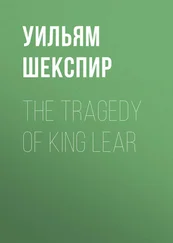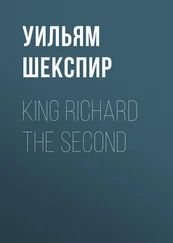уильям шекспир - King Lear
Здесь есть возможность читать онлайн «уильям шекспир - King Lear» весь текст электронной книги совершенно бесплатно (целиком полную версию без сокращений). В некоторых случаях можно слушать аудио, скачать через торрент в формате fb2 и присутствует краткое содержание. Год выпуска: 2011, ISBN: 2011, Издательство: Random House Publishing Group, Жанр: Старинная литература, на английском языке. Описание произведения, (предисловие) а так же отзывы посетителей доступны на портале библиотеки ЛибКат.
- Название:King Lear
- Автор:
- Издательство:Random House Publishing Group
- Жанр:
- Год:2011
- ISBN:978-1-58836-828-7
- Рейтинг книги:3 / 5. Голосов: 1
-
Избранное:Добавить в избранное
- Отзывы:
-
Ваша оценка:
- 60
- 1
- 2
- 3
- 4
- 5
King Lear: краткое содержание, описание и аннотация
Предлагаем к чтению аннотацию, описание, краткое содержание или предисловие (зависит от того, что написал сам автор книги «King Lear»). Если вы не нашли необходимую информацию о книге — напишите в комментариях, мы постараемся отыскать её.
King Lear — читать онлайн бесплатно полную книгу (весь текст) целиком
Ниже представлен текст книги, разбитый по страницам. Система сохранения места последней прочитанной страницы, позволяет с удобством читать онлайн бесплатно книгу «King Lear», без необходимости каждый раз заново искать на чём Вы остановились. Поставьте закладку, и сможете в любой момент перейти на страницу, на которой закончили чтение.
Интервал:
Закладка:

5. “What, art mad? A man may see how this world goes with no eyes”: the bleakness of Peter Brook’s 1962 production with Paul Scofield (left) as Lear and Alan Webb as the blinded Gloucester.
chronicles the process by which suffering turns self-pity and self-love into outward versions of themselves. In practice this means that Lear learns to identify with the poor and downtrodden, classes never far from the drab, pockmarked, nineteenth century face of this production. Indeed, the three-man directorate of Trevor Nunn, John Barton and Barry Kyle … do all they can to bring period penury to our attention, gratuitously introducing a troupe of vagrants to trot round the stage between scenes, and transforming Michael Williams’s Fool into a bald scrofulous relic, a seedily eccentric song-and-dance man who might have stumbled out of Bleak House … determined to stress that Lear is a social as well as an elemental play. 21
The setting for the 2004 production directed by Bill Alexander was of a postwar world in which the country was in a flux of insecurity, distinctly modern in feel but without reference to a specific time:
This Lear appears at times to be set in a crumbling mental home, backed by the scaffolding and half-destroyed brick walls of Tom Piper’s bleak setting. It suggests that a nuclear bomb has already fallen on Lear’s kingdom and the survivors are left wandering about trying to work out—post-Apocalypse—who they are and what has happened and above all where the hell they are supposed to be going next.… There is a bizarre timelessness here—so that in a post-Victorian world, when the old King comes on dressed like a mad deserter from the First World War, there is no real surprise, just the feeling that Alexander and his cast have had yet another disturbing thought about the many insights into madness and identity-crisis offered in the play. 22
Of the setting, designer Tom Piper explained:
Bill [Alexander] felt very strongly that you can’t set this play in one particular place, it has to be an invented world, so we’re aiming to create parallel worlds: the Victorian married with strange bits of technology.… I wanted to include a broken element, to convey a sense of a world that could be in decay or on the edge of industrialisation. 23
Corin Redgrave, a noted left-wing campaigner as well as a member of a distinguished acting dynasty, played Lear in this production. He saw the play as “modern, topical and relevant because it so vividly portrays a country divided by an almost impassable fault-line between those who have enough and those who don’t. Any attempt I make to build up an idea of Lear the man, Lear the ruler, is still very strongly influenced by that thinking.” 24
Again, although not overtly political in the actors’ focus, Adrian Noble’s 1993 production infused the political implication of Lear’s decision into the setting:
This production turned the map into paper flooring whose divisions the Fool (a gag over his mouth emphasizing his obvious outrage) was made to mark with red paint. It was then gradually reduced to tatters until the ground beneath, which was covered with a great blood-red stain, was wholly revealed. 25
There are numerous references in King Lear to the stars, gods, and the fates. Setting the play in a non-Christian era endows the play with an adaptable metaphysical stance that has international appeal. In 1999, Japanese director Yukio Ninagawa of the Sainokuni Shakespeare Company undertook a joint production with the RSC. This production focused on the elemental nature of the play, the dark forces of nature that emerge from the void created by Lear’s misjudgments:
This is a hauntingly but savagely beautiful production. Yukio Horio’s set is dominated by a huge black wooden walkway sloping gently toward you and widening into an immense platform. At the back the walkway seems to disappear into black darkness, whence the actors emerge like mythological figures, both real and remote. All this suggests the structure of the classical Noh stage, where the curtained entrance also leads somewhere indeterminate: a primeval darkness that holds no moral secrets … this reinforces the uncomfortable Shakespearian vision of a world where you are left without the consolation or guidance of a moral order. 26
The handling of the storm scene was particularly controversial. Boulders of various sizes were choreographed to drop onto the stage as Lear raged against the storm. Most audience members and reviewers were more concerned about the safety of the actors than the director’s vision, which “conjures a world in which Nature’s moulds are cracked.” 27
The breakdown in family relationships is, of course, central to King Lear and modern directors have often used this as an accessible focal point in productions. Initially produced as a touring production for schools, Buzz Goodbody’s small cast chamberpiece version of Lear in 1974
was performed by a cast of nine, with one musician playing gong, trumpet, snare and kettle drum. An all-purpose servant was added, while one sub-plot was cut (losing Albany, Cornwall, Oswald, and the French King).… The acting area was empty, except for a few props, like a rug and banners which unfurled when Lear appeared.… Scenes were set simply, using props and, as with the storm, music and lights, which at key moments in the production underscored the director’s point.… Lear was not seen as epic in terms of great public scenes of wide-open spaces peopled with a huge cast.… Its focus was on two families, in which the personal as well as the age differences played a more important part than is usually recognised. 28
In this powerful, intimate production, “the play as a whole became an intense study of private griefs of their two families, with Kent and the Fool both reduced to appalled outsiders, helplessly looking on.” 29
Described by critic Irving Wardle as “an all-too-familiar story of family life,” 30Nicholas Hytner’s 1990 production also turned Lear into a tale of dysfunctional family neurosis. He encoded his very cerebral reading in the set design of David Fielding, creating an enclosed space for the staging of Lear that took the form of a cube:
Open on one side with its outer walls painted to look like heavy steel, the cube simply revolves and stops, to present a succession of interiors and exteriors. Sometimes it will stop with a corner pointing toward the audience so that actors can stand out of sight of each other while Shakespearian eavesdropping can take place. In the storm scene, it will revolve continuously—the idea being that, as a metaphor for the world of the play (as well as Lear’s mental world), it is spinning out of control. 31
The effect of the cube was to reduce the scale of the play—something apparently deliberate in the director’s interpretation. Psychological and domestic, Lear’s world became both a mental ward and the interior of his mind, a controlled civilized space allowed to go mad through neglect and misjudgment. John Wood’s very human and neurotic Lear went on an inner and outer journey of physical suffering and mental awareness: “We are left with an interpretation which is as much medical as moral. The geriatric ward slugs it out with the psychiatric wing. There is little sense of hubris on the one hand, or of concentrated evil on the other.” 32The emphasis on Lear’s genuine insanity stemming from the family reflected the wider world of the play and the state of Britain. Michael Billington described it as “an exploration of the insane contradictions of a world where the gods are seen as both just and wantonly cruel, where Nature is both purifying and destructive.” 33
Читать дальшеИнтервал:
Закладка:
Похожие книги на «King Lear»
Представляем Вашему вниманию похожие книги на «King Lear» списком для выбора. Мы отобрали схожую по названию и смыслу литературу в надежде предоставить читателям больше вариантов отыскать новые, интересные, ещё непрочитанные произведения.
Обсуждение, отзывы о книге «King Lear» и просто собственные мнения читателей. Оставьте ваши комментарии, напишите, что Вы думаете о произведении, его смысле или главных героях. Укажите что конкретно понравилось, а что нет, и почему Вы так считаете.












